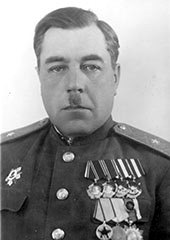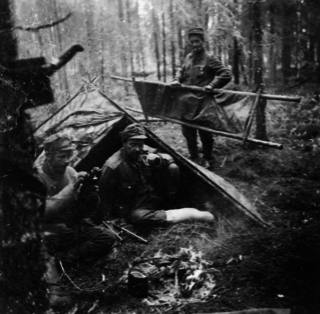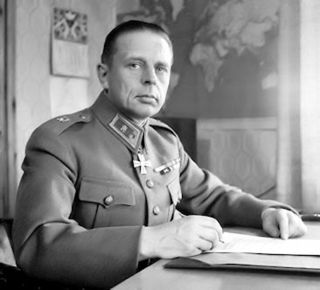Battle of Ilomantsi can refer to two battles:
- Battle of Ilomantsi (1939), between Finland and Soviet Union during the Winter War
- Battle of Ilomantsi (1944), between Finland and Soviet Union during the Continuation War
Battle of Ilomantsi can refer to two battles:

The Continuation War, also known as the Second Soviet-Finnish War, was a conflict fought by Finland and Nazi Germany against the Soviet Union during World War II. It began with a Finnish declaration of war and invasion on 25 June 1941 and ended on 19 September 1944 with the Moscow Armistice. The Soviet Union and Finland had previously fought the Winter War from 1939 to 1940, which ended with the Soviet failure to conquer Finland and the Moscow Peace Treaty. Numerous reasons have been proposed for the Finnish decision to invade, with regaining territory lost during the Winter War regarded as the most common. Other justifications for the conflict include Finnish President Risto Ryti's vision of a Greater Finland and Commander-in-Chief Carl Gustaf Emil Mannerheim's desire to annex East Karelia.

The Winter War was a war between the Soviet Union and Finland. It began with a Soviet invasion of Finland on 30 November 1939, three months after the outbreak of World War II, and ended three and a half months later with the Moscow Peace Treaty on 13 March 1940. Despite superior military strength, especially in tanks and aircraft, the Soviet Union suffered severe losses and initially made little headway. The League of Nations deemed the attack illegal and expelled the Soviet Union from its organization.

Karelia is an area in Northern Europe of historical significance for Russia, Finland, and Sweden. It is currently divided between northwestern Russia and Finland.

Ilomantsi is municipality and a village of Finland. It is located in the North Karelia region. The municipality has a population of 4,406 and covers an area of 3,172.69 square kilometres (1,224.98 sq mi) of which 409.01 km2 (157.92 sq mi) is water. The population density is 1.59 inhabitants per square kilometre (4.1/sq mi). The most eastern point of Finland and of the continental part of the European Union is located in Ilomantsi near the village of Hattuvaara.

The military history of Finland consists of hundreds of years of armed actions in the territory encompassing modern Finland.

The Vyborg–Petrozavodsk offensive or Karelian offensive was a strategic operation by the Soviet Leningrad and Karelian Fronts against Finland on the Karelian Isthmus and East Karelia fronts of the Continuation War, on the Eastern Front of World War II. The Soviet forces captured East Karelia and Vyborg/Viipuri. After that, however, the fighting reached a stalemate.

The Battle of Ilomantsi was a part of the Svir–Petrozavodsk Offensive of the Continuation War (1941–1944). It was fought from 26 July to 13 August 1944, between Finland and the Soviet Union in an area roughly 40 kilometers wide and 30 kilometers deep, near the Finnish-Soviet border, close to the Finnish village of Ilomantsi, in North Karelia. The battle ended with a Finnish victory—the last major Soviet attack against Finland was stopped here.

Major General Erkki Johannes Raappana was the commander of the 14th Division of the Finnish Army during the Second World War.

The Battle of Nietjärvi was part of the Continuation War between Finland and the Soviet Union, which occurred during World War II. The battle ended in a Finnish victory.
Hattuvaara is a village in Ilomantsi municipality in the province of Eastern Finland, about 40 km north-east from the municipality centre and near the border with Russia.

Finland–Germany relations are the bilateral relations between the Finland and Germany. Both countries are part of the European Union, are signatories of the Schengen Agreement, and are members of the eurozone and NATO. Germany supported Finland's NATO membership during Finland's accession into NATO, which was finalized on 4 April 2023.

Roman Ivanovich Panin was a Soviet major general from during World War II. An Imperial Russian Army junior officer in World War I, he joined the Red Army in 1919. Panin fought in the Russian Civil War and continued to serve after the end of the Russian Civil War. He was an advisor to the National Revolutionary Army between 1938 and 1939. Later he participated in the Soviet-Finnish war as a corps commander, and during World War II as the commander of the 14th Army, commanding the defense of Murmansk during Operation Silver Fox. Panin became commander of the 2nd Reserve Army in May 1942 and two months later became a lecturer at the Frunze Military Academy. In February 1943 he became Volkhov Front chief of combat training and in September led the 7th Rifle Corps. After participating in the Leningrad–Novgorod Offensive, Panin briefly led the 99th Rifle Corps. In July 1944, Panin became deputy commander of the 5th Army. Hospitalized in February 1945 during the East Prussian Offensive, Panin did not see further action. After recovering he became an instructor at the Frunze Military Academy and retired in 1949. He died shortly afterwards.

The Battle of Tali–Ihantala was part of the Finnish-Soviet Continuation War (1941–1944), which occurred during World War II. The battle was fought between Finnish forces—using war materiel provided by Germany—and Soviet forces. To date, it is the largest battle in the history of the Nordic countries.

Operation Hokki was a military operation that took place during World War II. The mission's objective was to destroy the railway yards of Petrozavodsk in order to prevent the enemy from supplying its troops in the Battle of Ilomantsi. The mission was conducted by Finland between 31 July 1944 and 31 August 1944 during the Continuation War. Because of the many setbacks that occurred, the objective of the mission was changed and the Finnish troops ended up destroying a large portion of railroad tracks that were being used to supply the Soviet troops in Ilomantsi. Operation Hokki is the only known Finnish airborne operation during World War II and was the largest landing operation in Finnish history.

Armas-Eino Martola was a Finnish general of the infantry, a knight of the Mannerheim Cross and a member of the Jäger Movement. He participated in the Eastern Front of World War I, the Finnish Civil War, the Winter War and the Continuation War. In his later years, he acted as the military advisor to the Secretary-General of the United Nations Dag Hammarskjöld and led the United Nations Peacekeeping Force in Cyprus from 1966 to 1969.

Filipp Danilovich Gorelenko was a Soviet Army lieutenant general and a Hero of the Soviet Union.

Einar Nikolai Mäkinen was a Finnish lieutenant general and a member of the Jäger movement. He participated in the Eastern Front of World War I, the Finnish Civil War, the Winter War and the Continuation War. Before the Continuation War, he participated in negotiations with the Germans regarding plans for the war.
The II Corps was a unit of the Finnish Army during the Continuation War. During the war the corps participated in combat first northwest of Lake Ladoga and on the Karelian Isthmus before moving to the Povenets–Lake Segozero region by late 1941. During the Soviet offensive of 1944, the corps conducted a fighting retreat to the region of Ilomantsi, with parts of its forces participating in the subsequent Battle of Ilomantsi.
The VI Corps was a corps of the Finnish Army during the Continuation War of 1941 to 1944, where the Finnish Army fought alongside Germans against the Soviet Union. The unit was formed during a reorganization of other Finnish army corps on 29 June 1941, prior to the start of Finnish offensive operations on the night of 9–10 July.
The Battle of Ilomantsi was fought from 10 December to 16 December 1939, between Finland and the Soviet Union during the Winter War. Fighting took place near the village of Ilomantsi, in North Karelia, Finland.